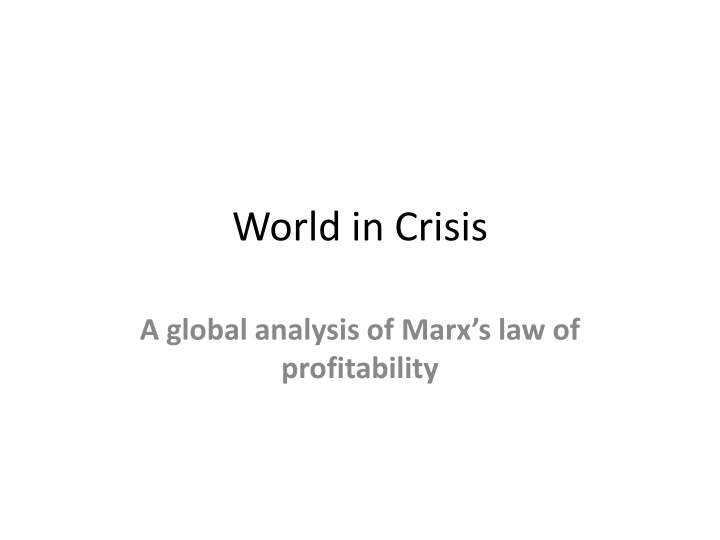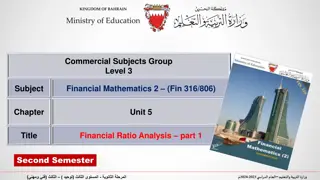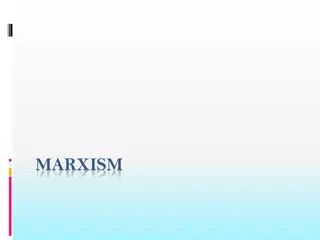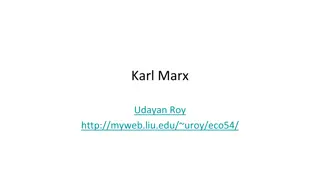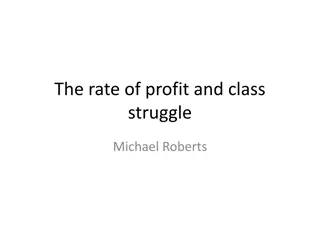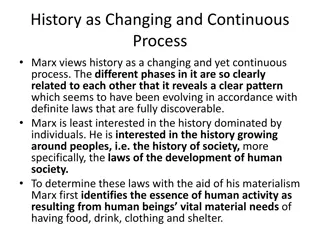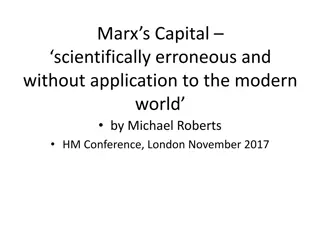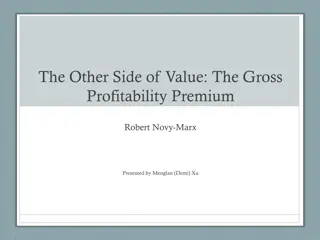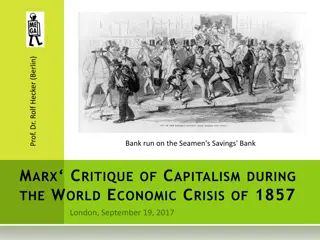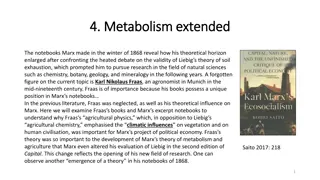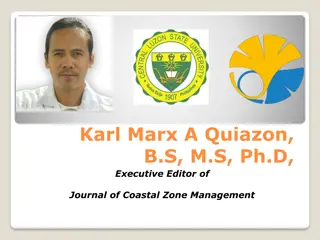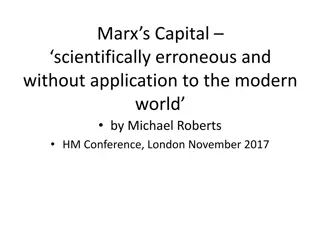Global Analysis of Marx's Law of Profitability
This analysis delves into the hypothesis that economic crises in modern economies stem from Marx's law of the tendential fall in the rate of profit. The book presents empirical evidence supporting this theory, illustrating how technological progress impacts labor productivity, value generation, and the realization of surplus value. The study highlights the inherent contradiction of capitalism and its impact on profitability, ultimately suggesting that resolving capitalist crises requires rethinking the mode of production itself.
Download Presentation

Please find below an Image/Link to download the presentation.
The content on the website is provided AS IS for your information and personal use only. It may not be sold, licensed, or shared on other websites without obtaining consent from the author.If you encounter any issues during the download, it is possible that the publisher has removed the file from their server.
You are allowed to download the files provided on this website for personal or commercial use, subject to the condition that they are used lawfully. All files are the property of their respective owners.
The content on the website is provided AS IS for your information and personal use only. It may not be sold, licensed, or shared on other websites without obtaining consent from the author.
E N D
Presentation Transcript
World in Crisis A global analysis of Marx s law of profitability
The book The World in Crisis has a specific aim: to provide empirical validity to the hypothesis that the cause of recurring and regular economic crises or slumps in output, investment, and employment in modern economies can be found in Marx s law of the tendential fall in the rate of profit. The book collates the empirical work of mainly young Marxist scholars from around the world (the Americas, Europe, and Asia) that supports empirically the validity of Marx s law of profitability as a theory of crises and, in particular, the recent Great Recession. The law reveals that crises arise from the very essence of capitalism, namely that, technological progress, while increasing labor productivity, at the same time replaces labor with means of production thus decreasing the value of the greater output. If less value and surplus value is generated, less value and surplus value can be realized. This is the root cause of falling profitability and crises. It reveals itself as an ever-changing complex articulation of the tendency and changing counter-tendencies, which give each crisis its own specific features. But the underlying cause is the same. Marx s law implies the unpalatable truth that capitalist crises cannot be permanently ended without ending the capitalist mode of production itself.
US rate of profit (rolling 10yr) Carchedi & Roberts 100 95 90 85 80 75 70 1955 1959 1963 1967 1971 1975 1979 1983 1987 1991 1995 1999 2003 2007 2011
US corporate profits, real investment, and GDP Q1-2001 to Q2-2012 ($bn). 2500 17000 2300 16500 Corporate profits peaked first in 2006, business investment and GDP peak later in 2008 2100 16000 1900 15500 1700 15000 1500 14500 1300 14000 Corporate profits recover first at end-2008, investment and GDP recover six months later in mid-2009 1100 13500 900 13000 700 12500 500 12000 Q1 2001 Q4 2001 Corporate profits Q3 2002 Q2 2003 Q1 2004 Q4 2004 Q3 2005 Q2 2006 Q1 2007 Q4 2007 Q3 2008 Q2 2009 Q1 2010 Q4 2010 Q3 2011 Q2 2012 Q1 2013 Q4 2013 Q3 2014 Q2 2015 Business investment GDP - right hand scale
The Keynesian and Marxist multipliers in the US from the 1970s 1.8 Ratios of change in net return on capital to real GDP (ROP) and change in government spending to real GDP 1.61 1.6 1.41 1.4 1.2 1.0 1.0 0.92 0.8 0.6 0.5 0.44 0.4 0.3 0.1 0.2 0.02 0.0 0.0 1971-80 1980-90 1990-00 2002-07 2008-14 ROP Govt exp
Rate of profit with (CE) and without (VE) constant exploitation Carchedi 25 20 15 10 5 0 CE-ARP RHS VE-ARP LHS
Three countertendencies The OCC does not necessarily rise and the rate of profit does not necessarily fall due to technological innovations Capitalists can increase their profitability by increasing the rate of exploitation Faced with falling profitability in the productive sphere, capital shifts from low profitability in the productive sectors to high profitability in the financial (i.e. unproductive) sectors.
Financial crises and fall in profits 0 -10 -20 -30 -40 -50 -60 -70 -80 1961 1975 1982 1998 2000 2007 2008 %fall in financial profits % fall in real profits
Investment, profits and crises Tapia Analyzing business cycles means neither more nor less than analyzing the economic process of the capitalist era Cycles are not, like tonsils, separable things that might be treated by themselves, but are, like the beat of the heart, of the essence of the organism that displays them. Joseph A. Schumpeter (1939)
Profits call the tune The evidence is quite overwhelming that profits peak several quarters before the recession, while investment peaks immediately before the recession. Then profits recover before investment does, as illustrated by the investment trough that occurs around the end of the recession or the start of the expansion but following the profit trough for at least a few quarters -Tapia
The international dimension A world rate of profit - Maito 45% 40% 35% 30% Periphery 25% World Core 20% 15% 10% 5% 1955 1957 1959 1961 1963 1965 1967 1969 1971 1973 1975 1977 1979 1981 1983 1985 1987 1989 1991 1993 1995 1997 1999 2001 2003 2005 2007 2009
Japans two decades Sato 35.0% 30.0% 25.0% 20.0% 15.0% 10.0% 5.0% 0.0% 1960FY 1962FY 1964FY 1966FY 1968FY 1970FY 1972FY 1974FY 1976FY 1978FY 1980FY 1982FY 1984FY 1986FY 1988FY 1990FY 1992FY 1994FY 1996FY 1998FY 2000FY 2002FY 2004FY 2006FY 2008FY 2010FY 2012FY 2014FY
The UKs decline Roberts UK rate of profit 1855-2009 (%) 27 35% 25 30% 23 25% 21 20% 19 17 15% 15 10% 13 5% 11 9 0% 1855 1863 1871 1879 1887 1895 1903 1911 1919 1927 1935 1943 1951 1959 1967 1975 1983 1991 1999 2007 ONS-BOE (a) MAITO - RHS (b)
Spains long depression Mateo 45.0 42.5 40.0 37.5 35.0 32.5 30.0 27.5 25.0 22.5 20.0 1995 1996 1997 1998 1999 2000 2001 2002 2003 2004 2005 2006 2007 2008 2009 2010 2011 2012 2013 2014 Total Exc. FIRE Exc FIRE and GOV
The Greek economy Maniatas & Passas 0.40 stagflation crisis 0.35 neoliberalism 0.30 crisis 0.25 "golden age" 0.20 net r 0.15 0.10 0.05 0.00 1958 1962 1966 1970 1974 1978 1982 1986 1990 1994 1998 2002 2006 2010
The profit rate in Brazil, 19532008 Marquetti, Maldonado, Lautert 125 100 75 Percent 50 Trend Actual 25 0 1953 1957 1961 1965 1969 1973 1977 1981 1985 1989 1993 1997 2001 2005
Chinese economic crisis Gaulard
Credit, fictitious capital, and crises Debt matters - Roberts Deleveraging excessive debt is part of the task of the current depression. Restoring profitability so that companies will start a period of sustained investment depends on reducing the debt burden. But corporate leverage is higher at this point of business cycle than in recoveries from previous recessions. That does not bode well for a quick escape from the depression if interest rates on debt start to rise.
Corporate debt US non financial companies: net debt to assets (%) Debt ratio improves as asset values improve, but debt ratio remains at high level 23 22 21 20 Debt ratio rockets as the value of corporate assets plummets in financial crash 19 18 17 16 15 2001-Q1 2001-Q3 2002-Q1 2002-Q3 2003-Q1 2003-Q3 2004-Q1 2004-Q3 2005-Q1 2005-Q3 2006-Q1 2006-Q3 2007-Q1 2007-Q3 2008-Q1 2008-Q3 2009-Q1 2009-Q3 2010-Q1 2010-Q3 2011-Q1 2011-Q3 2012-Q1 2012-Q3 2013-Q1 2013-Q3
The neoliberal financialization C mara & Mari a 10% 8% 6% 4% 2% 0% -2% -4% 1950 1952 1954 1956 1958 1960 1962 1964 1966 1968 1970 1972 1974 1976 1978 1980 1982 1984 1986 1988 1990 1992 1994 1996 1998 2000 2002 2004 2006 2008 2010 2012 2014 2016 Profitability of active-capital Profitability of capital-property
The fictitious US economy Smith & Butovsky 0.16 0.14 0.12 0.1 0.08 0.06 0.04 0.02 y = -0.0014x + 0.1165 0
The speculative heart of capital Norfield
High frequency trading Nash Speculative capital is self-destructive; it eliminates the opportunities that give rise to it. Although it then seeks new opportunities, its self-destructive tendency never goes away. Speculative capital has the final say in matters of markets with results that are plain for everyone to see: a crash-prone market conveying no useful information, and thus serving no purpose, sustained by the feverish activity of the same HFT that perverted the prices in the first place. Such is the ironic state of affairs that the self-destructive tendency of speculative capital ultimately brings about.
The euro crisis Carchedi Whether to stay in or to leave the euro is a decision that should be embedded in a wider strategy of radical change centred upon the transformation of the capitalist production relation. In taking this decision, due notice should be taken of the real effect of competitive devaluation. Outside of this perspective, to exit or not to exit is a meaningless question.
Euro: a crisis of global capitalism Roberts Where the recovery in profitability has been weak or non-existent, real GDP has contracted the most since 2009. 20.0 % change in real GDP 2010-15 15.0 10.0 5.0 0.0 -5.0 Correlations: G6 0.74 GIPS 0.86 ALL 0.48 -10.0 -15.0 -20.0 % change in net return on capital 2010-15 -25.0 -10.0 -5.0 0.0 5.0 10.0 15.0 20.0 25.0 30.0 35.0
The youth Finally, our contributors are mainly young scholars. We wanted this book to allow readers to discover the excellent work being done by young Marxist economists around the globe to show that it is not just ageing (and possibly declining) Marxist economists (like the editors) who fly the flag of Marxist economic analysis in the early 21st century.
